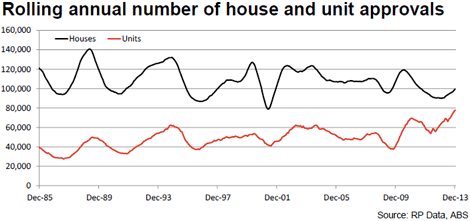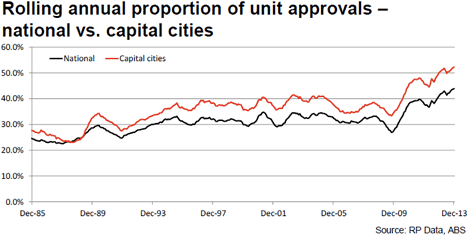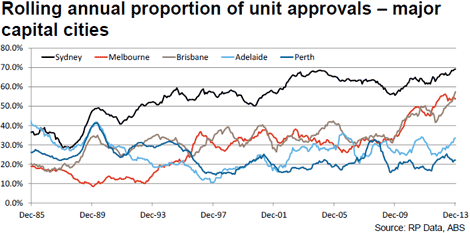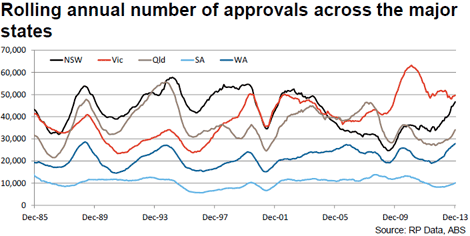Australia transitioning from a reliance on the resource sector to housing construction
A rebound in activity across Australia’s property market is having a flow on effect to other industry sectors; particularly dwelling approvals where, based on recently released Australian Bureau of Statistics (ABS) results, throughout 2013 there were 177,418 residential dwelling approvals.
Australia’s economic reliance is transitioning away from the resources sector to housing construction where according to the ABS building approvals data, there has been a sharp rebound in dwelling approvals through 2013. This is exactly what the RBA was hoping for.
Based on the ABS results, there were 177,418 residential dwelling approvals in 2013; the annual number of dwelling approvals was 15.7% higher over the year which represented the greatest annual increase since January 2011. The 177,418 dwelling approvals was also the greatest number of approvals since January 2011.
A valuable point of interest in the ABS data is that a vast majority of dwelling approvals continue to be granted to the private sector, with the public sector playing little part in the construction of new homes. Over the year, 98% of all dwelling approvals were to the private sector, which is encouraging.
The improvement across the housing sector is important for a number of reasons.
Housing construction is one of the key economic pillars that policy makers are looking towards to assist with the economic transition away from mega-infrastructure projects related to the resource sector which is winding down. Additionally, housing construction provides a significant multiplier effect on the Australian economy, providing more jobs and demand for building materials, home furnishings, appliances and white goods.
Points of interest - house and unit approvals:
• More approvals were granted for units at 77,909 approvals – an increase of 23.4% over the year
• 99,508 house approvals – an increase of 10.4% over the year which was the greatest annual increase since October 2010.

Looking specifically at the 77,909 unit approvals, this was the greatest number of annual unit approvals on record. As a result, units also accounted for a record high 43.9% of all dwelling approvals throughout 2013. Placing the heightened level of unit approvals into perspective, 10 years ago 32.6% of all approvals were for units whereas 20 years ago, they accounted for 30.0% of approvals.
Clearly, there is a significant push towards higher density development and this is particularly the case within capital cities.
While 43.9% of national dwelling approvals were for units in 2013, across the combined capital cities the figure was recorded at 52.3%.

Looking across the individual capital cities, all recorded more than half of all approvals for units over the year:
• Sydney (69.2%)
• Melbourne (53.7%)
• Brisbane (57.5%)
• Darwin (63.2%)
• Canberra (67.2%)
• Elsewhere 33.6% of Adelaide approvals were for units, 22.1% in Perth and 25.6% in Hobart.

The results also show that more than 50% of approvals have been for units in Sydney since 1992, in Melbourne since mid-2012 and in Brisbane since early 2003. Sydney has for a long time had a focus on higher levels of densification whereas it is a relatively new phenomenon across other capital cities.
The shift to more unit approvals over houses is indicative of ongoing densification of our capital cities as well as developers seeking to utilise land parcels to their highest and best use which is often multi-level development.

On a state by state basis, dwelling approval increases have been broad-based where approvals are -4.1% lower than a year ago in Victoria (after a strong run up in approvals during 2009/10) and -8.7% lower in Hobart. In all other states, approvals are higher than a year ago; the largest increases were located in: New South Wales (27.7%), Queensland (22.0%), South Australia (22.6%), Western Australia (32.3%), Northern Territory (47.5%) and Australian Capital Territory (41.1%).
Tasmania is the only state where home values continue to trend lower and Victorian dwelling approvals have been elevated over recent years while other states have recorded low levels of approval.
Overall the ABS results are encouraging and highlight that dwelling approvals are increasing. Based on the trend, it looks as if the housing pipeline is set to continue growing.
Ongoing densification across select capital cities is also reflective of changing lifestyle patterns and growing demand for inner city living. Based on this, we would expect that the proportion of unit approvals will continue to grow as the population increases and many property purchasers show a preference for living closer to the centre of cities at more affordable prices than those available for detached houses.
Cameron Kusher is senior research analyst at RP Data.
